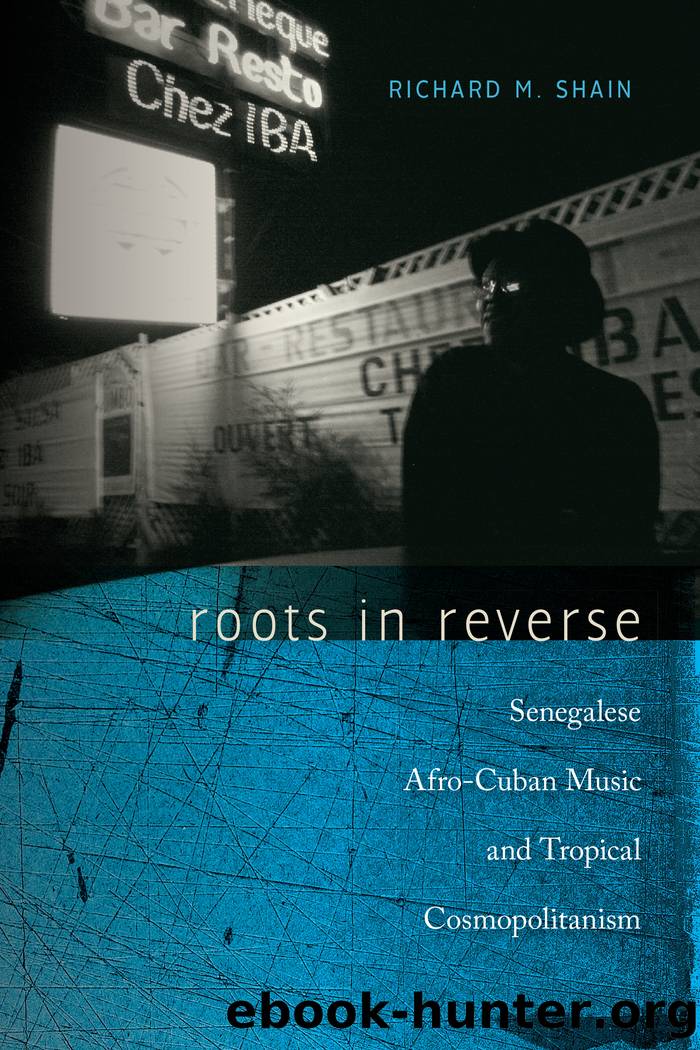Roots in Reverse by Shain Richard M

Author:Shain, Richard M.
Language: eng
Format: epub
Publisher: Wesleyan University Press
Published: 2018-08-14T16:00:00+00:00
âWE ALL DIED FOR SALSAâ: THE DECLINE OF SENEGALESE AFRO-CUBAN MUSIC IN THE 1980S
By the late 1970s Senegalese Latin music had been the dominant music in Senegalese clubs, recording studios, and radio stations for a generation. Dakarâs boîtes were filled with patrons whose appetite for Cuban dance music was insatiable. Senegalese groups like Orchestre Baobab and No. 1 produced Latin-infused recordings of artistic distinction. Senegalese radio regularly broadcast the music of such Cuban ensembles as Orquesta Aragón and Orquesta Broadway. Senegal had become an obligatory stop on the touring itineraries of New Yorkâbased Latin music ensembles, and Senegalese and Ivorian impresarios even traveled to the United States to record Afro-Cuban music for the Senegalese market. Though ignored by the Senegalese government, Latin musicâs hold on the popular imagination seemed secure.
Within five years, however, the rise of what came to be known as mâbalax ensembles almost completely eclipsed Afro-Cuban music.18 These new bands relegated Afro-Cuban rhythms, melodies, and harmonies to the background in favor of mostly Wolof drumming and singing traditions. The gentle sway of the cha-cha-chá was replaced by the gyrations of new dance styles. Wolof âfolkloricâ musical forms long had been part of many bandsâ repertoires. Numerous recordings exist of mâbalax-tinged music from the 1970s by the Star Band and No. 1. Even Orchestre Baobab, despite its Casamance orientation, performed some Wolof material (as did the Super Eagles band of neighboring Gambia, whose work greatly influenced NâDour).19 Other bands, such as Diamono, emphasized mâbalax rhythms and sabar drumming more than the Afro-Cuban bands.20 Ndaga and traditional ensembles went even further in their explorations of local musical traditions and attracted sizable audiences. While to many listeners outside of Senegal, local Latin music and mâbalax sound similar, to Senegalese ears the two genres of music are separate and distinct. Sometimes their meters overlap, but the arrangements distinguish one from the other. Mâbalax is more percussive and often is played at a rapid clip. Afro-Cuban bands by contrast aim for fluidity and restraint. The bass lines are especially different. Senegalese Afro-Cuban bass players lay down a beat heavily indebted to the clave, while mâbalax bassists instead are influenced by jazz and rock.21
When mâbalax rose to prominence in the 1980s, it was the culmination of a gradual process through which ensembles had adjusted their song lists to reflect the new preferences of their publics. Even more important, what sometimes has been presented in African musical studies as a debate about modernity was actually a conversation within Senegalese modernity that involved changes in government policies, economic and social crises, competing generations, and the development of a local entertainment âbusiness.â While this process of redefinition in the 1980s was dramatic, it was part of a long conversation about authenticity and cosmopolitanism in Senegal that began before the ascent of mâbalax and still continues today.
In 1981, after twenty-one years in office, Senegalâs first president, Léopold Sédar Senghor retired and was replaced by Abdou Diouf, a leading member of his Socialist Party.22 While the handing over of
Download
This site does not store any files on its server. We only index and link to content provided by other sites. Please contact the content providers to delete copyright contents if any and email us, we'll remove relevant links or contents immediately.
| Africa | Americas |
| Arctic & Antarctica | Asia |
| Australia & Oceania | Europe |
| Middle East | Russia |
| United States | World |
| Ancient Civilizations | Military |
| Historical Study & Educational Resources |
The Dawn of Everything by David Graeber & David Wengrow(1654)
The Bomber Mafia by Malcolm Gladwell(1583)
Facing the Mountain by Daniel James Brown(1504)
Submerged Prehistory by Benjamin Jonathan; & Clive Bonsall & Catriona Pickard & Anders Fischer(1420)
Wandering in Strange Lands by Morgan Jerkins(1372)
Tip Top by Bill James(1351)
Driving While Brown: Sheriff Joe Arpaio Versus the Latino Resistance by Terry Greene Sterling & Jude Joffe-Block(1339)
Evil Geniuses: The Unmaking of America: A Recent History by Kurt Andersen(1320)
Red Roulette : An Insider's Story of Wealth, Power, Corruption, and Vengeance in Today's China (9781982156176) by Shum Desmond(1315)
The Way of Fire and Ice: The Living Tradition of Norse Paganism by Ryan Smith(1305)
American Kompromat by Craig Unger(1271)
It Was All a Lie by Stuart Stevens;(1265)
F*cking History by The Captain(1254)
American Dreams by Unknown(1236)
Evil Geniuses by Kurt Andersen(1224)
Treasure Islands: Tax Havens and the Men who Stole the World by Nicholas Shaxson(1222)
White House Inc. by Dan Alexander(1179)
The First Conspiracy by Brad Meltzer & Josh Mensch(1140)
The Fifteen Biggest Lies about the Economy: And Everything Else the Right Doesn't Want You to Know about Taxes, Jobs, and Corporate America by Joshua Holland(1092)
